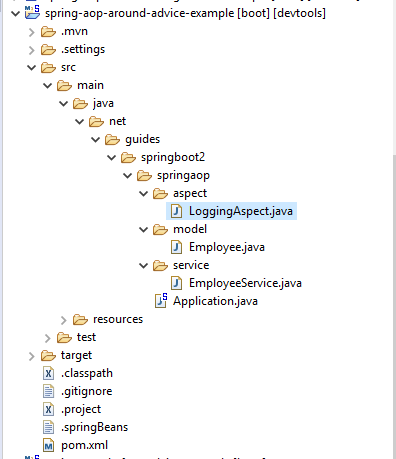In this Spring AOP example, we will learn to use AspectJ @Around annotation in Spring-based applications. @Around annotated methods run before and after all methods matching with pointcut expression.
In this example, We will create a simple spring boot application, add a logging aspect and then invoke aspect methods based on pointcuts information passed in a @Around annotation.
AspectJ @Around Annotation Quick Example
The below snippet shows the usage of @Around annotation:
@Aspect @Component public class LoggingAspect { private final Logger LOGGER = LoggerFactory.getLogger(this.getClass()); @Around("execution(* net.guides.springboot2.springaop.service.EmployeeService.*(..))") public void logAroundAllMethods(ProceedingJoinPoint joinPoint) throws Throwable { LOGGER.debug("****LoggingAspect.logAroundAllMethods() : " + joinPoint.getSignature().getName() + ": Before Method Execution"); try { joinPoint.proceed(); } finally { //Do Something useful, If you have } LOGGER.debug("****LoggingAspect.logAroundAllMethods() : " + joinPoint.getSignature().getName() + ": After Method Execution"); } @Around("execution(* net.guides.springboot2.springaop.service.EmployeeService.getEmployeeById(..))") public void logAroundGetEmployee(ProceedingJoinPoint joinPoint) throws Throwable { LOGGER.debug("****LoggingAspect.logAroundGetEmployee() : " + joinPoint.getSignature().getName() + ": Before Method Execution"); try { joinPoint.proceed(); } finally { //Do Something useful, If you have } LOGGER.debug("****LoggingAspect.logAroundGetEmployee() : " + joinPoint.getSignature().getName() + ": After Method Execution"); } @Around("execution(* net.guides.springboot2.springaop.service.EmployeeService.addEmployee(..))") public void logAroundAddEmployee(ProceedingJoinPoint joinPoint) throws Throwable { LOGGER.debug("****LoggingAspect.logAroundAddEmployee() : " + joinPoint.getSignature().getName() + ": Before Method Execution"); try { joinPoint.proceed(); } finally { //Do Something useful, If you have } LOGGER.debug("****LoggingAspect.logAroundAddEmployee() : " + joinPoint.getSignature().getName() + ": After Method Execution"); } }
Let's demonstrate the usage of @Around annotation with a complete step-by-step example.
Creating a Spring Boot Application
There are many ways to create a Spring Boot application. You can refer below articles to create a Spring Boot application.
>> Create Spring Boot Project With Spring Initializer
>> Create Spring Boot Project in Spring Tool Suite [STS]
>> Create Spring Boot Project in Spring Tool Suite [STS]
Refer next step to create a project packaging structure.
Maven Dependencies
<?xml version="1.0" encoding="UTF-8"?>
<project
xmlns="http://maven.apache.org/POM/4.0.0"
xmlns:xsi="http://www.w3.org/2001/XMLSchema-instance"
xsi:schemaLocation="http://maven.apache.org/POM/4.0.0 http://maven.apache.org/xsd/maven-4.0.0.xsd">
<modelVersion>4.0.0</modelVersion>
<groupId>net.guides.springboot2</groupId>
<artifactId>springboot2-springaop-example</artifactId>
<version>0.0.1-SNAPSHOT</version>
<packaging>jar</packaging>
<name>springboot2-springaop-example</name>
<description>Demo project for Spring Boot</description>
<parent>
<groupId>org.springframework.boot</groupId>
<artifactId>spring-boot-starter-parent</artifactId>
<version>3.0.4</version>
<relativePath />
<!-- lookup parent from repository -->
</parent>
<properties>
<project.build.sourceEncoding>UTF-8</project.build.sourceEncoding>
<project.reporting.outputEncoding>UTF-8</project.reporting.outputEncoding>
<java.version>17</java.version>
</properties>
<dependencies>
<dependency>
<groupId>org.springframework.boot</groupId>
<artifactId>spring-boot-starter-aop</artifactId>
</dependency>
</dependencies>
<build>
<plugins>
<plugin>
<groupId>org.springframework.boot</groupId>
<artifactId>spring-boot-maven-plugin</artifactId>
</plugin>
</plugins>
</build>
</project>Create an Aspect - LogginAspect.java
package net.guides.springboot2.springaop.aspect; import org.aspectj.lang.ProceedingJoinPoint; import org.aspectj.lang.annotation.Around; import org.aspectj.lang.annotation.Aspect; import org.slf4j.Logger; import org.slf4j.LoggerFactory; import org.springframework.stereotype.Component; /** * Aspect for logging execution. * * @author Ramesh Fadatare * */ @Aspect @Component public class LoggingAspect { private final Logger LOGGER = LoggerFactory.getLogger(this.getClass()); @Around("execution(* net.guides.springboot2.springaop.service.EmployeeService.*(..))") public void logAroundAllMethods(ProceedingJoinPoint joinPoint) throws Throwable { LOGGER.debug("****LoggingAspect.logAroundAllMethods() : " + joinPoint.getSignature().getName() + ": Before Method Execution"); try { joinPoint.proceed(); } finally { //Do Something useful, If you have } LOGGER.debug("****LoggingAspect.logAroundAllMethods() : " + joinPoint.getSignature().getName() + ": After Method Execution"); } @Around("execution(* net.guides.springboot2.springaop.service.EmployeeService.getEmployeeById(..))") public void logAroundGetEmployee(ProceedingJoinPoint joinPoint) throws Throwable { LOGGER.debug("****LoggingAspect.logAroundGetEmployee() : " + joinPoint.getSignature().getName() + ": Before Method Execution"); try { joinPoint.proceed(); } finally { //Do Something useful, If you have } LOGGER.debug("****LoggingAspect.logAroundGetEmployee() : " + joinPoint.getSignature().getName() + ": After Method Execution"); } @Around("execution(* net.guides.springboot2.springaop.service.EmployeeService.addEmployee(..))") public void logAroundAddEmployee(ProceedingJoinPoint joinPoint) throws Throwable { LOGGER.debug("****LoggingAspect.logAroundAddEmployee() : " + joinPoint.getSignature().getName() + ": Before Method Execution"); try { joinPoint.proceed(); } finally { //Do Something useful, If you have } LOGGER.debug("****LoggingAspect.logAroundAddEmployee() : " + joinPoint.getSignature().getName() + ": After Method Execution"); } }
Create a Java POJO - Employee.java
package net.guides.springboot2.springaop.model;
public class Employee {
private long id;
private String firstName;
private String lastName;
private String emailId;
public Employee() {
}
public Employee(long id, String firstName, String lastName, String emailId) {
this.id = id;
this.firstName = firstName;
this.lastName = lastName;
this.emailId = emailId;
}
public long getId() {
return id;
}
public void setId(long id) {
this.id = id;
}
public String getFirstName() {
return firstName;
}
public void setFirstName(String firstName) {
this.firstName = firstName;
}
public String getLastName() {
return lastName;
}
public void setLastName(String lastName) {
this.lastName = lastName;
}
public String getEmailId() {
return emailId;
}
public void setEmailId(String emailId) {
this.emailId = emailId;
}
@Override
public String toString() {
return "Employee [id=" + id + ", firstName=" + firstName + ", lastName=" + lastName + ", emailId=" + emailId
+ "]";
}
}
Create service methods - EmployeeService.java
Let's create a few service methods for Employee on which aspects need to be executed.
package net.guides.springboot2.springaop.service;
import java.util.ArrayList;
import java.util.List;
import org.springframework.stereotype.Service;
import net.guides.springboot2.springaop.model.Employee;
/**
* Employee Service
*
* @author Ramesh
*
*/
@Service
public class EmployeeService {
private List < Employee > employees = new ArrayList < > ();
public List < Employee > getAllEmployees() {
System.out.println("Method getAllEmployees() called");
return employees;
}
public Employee getEmployeeById(Long employeeId) {
System.out.println("Method getEmployeeById() called");
for (Employee employee: employees) {
if (employee.getId() == Long.valueOf(employeeId)) {
return employee;
}
}
return null;
}
public void addEmployee(Employee employee) {
System.out.println("Method addEmployee() called");
employees.add(employee);
}
public void updateEmployee(Employee employeeDetails) {
System.out.println("Method updateEmployee() called");
for (Employee employee: employees) {
if (employee.getId() == Long.valueOf(employeeDetails.getId())) {
employees.remove(employee);
employees.add(employeeDetails);
}
}
}
public void deleteEmployee(Long employeeId) {
System.out.println("Method deleteEmployee() called");
for (Employee employee: employees) {
if (employee.getId() == Long.valueOf(employeeId)) {
employees.remove(employee);
}
}
}
}
Test Spring AspectJ Configuration and Execution
Now let’s test whether the above-configured aspects execute on given pointcut information using Spring boot Application:
package net.guides.springboot2.springaop;
import org.springframework.boot.SpringApplication;
import org.springframework.boot.autoconfigure.SpringBootApplication;
import org.springframework.context.ApplicationContext;
import net.guides.springboot2.springaop.model.Employee;
import net.guides.springboot2.springaop.service.EmployeeService;
@SpringBootApplication
public class Application {
public static void main(String[] args) {
ApplicationContext applicationContext = SpringApplication.run(Application.class, args);
EmployeeService employeeService = applicationContext.getBean(EmployeeService.class);
employeeService.addEmployee(new Employee(100 L, "ramesh", "fadatare", "ramesh@gmail.com"));
employeeService.getEmployeeById(100 L);
employeeService.getAllEmployees();
}
}
From the above diagram, it clears that aspect advice executed on relevant joinpoints.
To learn more about Spring AOP then check out the complete Spring AOP Tutorial.



Comments
Post a Comment
Leave Comment